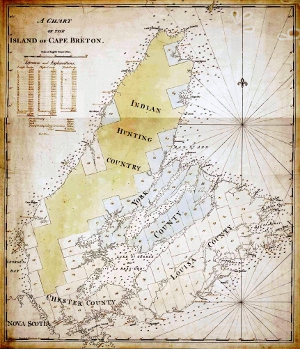
Island of Cape Breton, 1767. Samuel Holland. Map 655. Beaton Institute, Cape Breton University.
The Mi’kmaq are a First Nations people whose traditional territory, called Mi’kma’ki, encompasses Nova Scotia, New Brunswick, Prince Edward Island, the Gaspe Peninsula, and parts of southwestern Newfoundland and northern Maine. The Mi’kmaq, along with the Abenaki, Maliseet, Passamaquoddy, and Penobscot, were united in the Wabenaki Confederacy, which was formed in the late seventeenth century as an allied response to the forces of colonization. These peoples, who reside in the East, are known as the “People of the Dawn.”
In 1752, the Mi’kmaq signed a Treaty of Peace and Friendship with the British Crown, which secured hunting and fishing rights that remain in effect today. This treaty is commemorated annually on October 1st, marking the start of Mi’kmaw history month in Nova Scotia.
The Mi’kmaq, who refer to themselves as L’nu’k (meaning “the people”), speak the Algonquian language Mi’kmaq, which has been represented through a variety of different orthographies including Pacifique, Rand, and Metallic. In 1982, the Grand Council adopted the Smith-Francis orthography in which Mi’kmaq is the plural noun and Mi’kmaw is the singular noun and adjectival form.
The selections chosen to showcase Mi’kmaw culture on this website fall into four broad categories: traditional songs, Catholic hymns, fiddle traditions, and contemporary works. The traditional songs largely draw upon the Ko’jua repertoire, a genre of dance music. The Catholic hymns can be divided into “old” and “new” traditions, where “old” refers to songs from the Gregorian chant tradition and “new” refers to more recent repertoire, such as “Immaculate Mary,” that has been translated into Mi’kmaq.
The Mi’kmaw fiddle tradition demonstrates a diversity of playing styles and repertoires, including tunes from the standard repertoire, as well as the adaptation of traditional song to fiddle (as in Lee Cremo’s playing of Ko’jua).
Finally, the contemporary works focus on the poetry of Rita Joe, some of which was set to music and is popular with school choirs. While it may seem unusual to some that spoken poetry has been included in this section, it should be noted that the Mi’kmaw word most commonly used in association with music is welta’q, which literally means “it sounds good.” As such, it can refer to any sound that is pleasing to the ear, including songs, stories, and poetry.
Ajipjulnek wulaptmnew wula Ikaniwikasik wjit Mi’kmaq ta’n telo’tijik.
Janice Esther Tulk, Ethnomusicologist
Mi'kmaq Songs
- Fiddle Selections (Jimmy Paul) [Video] Jimmy Googoo
- Fiddle Selections (Lee Cremo) Lee Cremo
- Fiddle selections (Wilfred Prosper) Wilfred Prosper
- God Save The Queen Harriet Denny Annie Cremo
- I Am An Indian On This Land [Video] Rita Joe
- I’ko (Michael Paul) Michael Paul
- I’ko (Sarah Denny) Sarah Denny
- Il Est Né Le Divin Enfant [Video] Mi’kmawey School Choir
- Kepmite’tmnej, Mi’kmaw Honour Song [Video] Dancing Eagles Drum Group
- Ko’jua – Jukwa’lu’k Kwe’ji’ju’ow Lee Cremo
- Ko’jua – Jukwa’lu’k Kwe’ji’ju’ow [Video 1] Lee Cremo
- Ko’jua – Jukwa’lu’k Kwe’ji’ju’ow [Video 2] Lee Cremo
- Ko’jua (Grand Entry) Noel P. Denny
- Ko’jua (Lee Cremo) [Video] Lee Cremo
- Ko’jua (Noel Denny) Noel P. Denny
- Ko’jua (Noel Marshall) [Video] Noel Marshall
- Kulein Unknown Singer
- Kwa’nu’te’ [Video] Sarah Denny
- Kyrie Noel P. Denny
- Mi’kmaq Lament For The Dead [Video] Rita Joe
- O’ Come All Ye Faithful [Video] Mi’kmawey School Choir
- Offertory Wilfred Prosper
- Paddy On The Turnpike Lee Cremo
- Pange Lingua Noel P. Denny
- The Oka Song [Video] Rita Joe
- Timothy Ryan’s Reel Lee Cremo
- Two Roads [Video] Rita Joe
- Wapikatji’j Sarah Denny